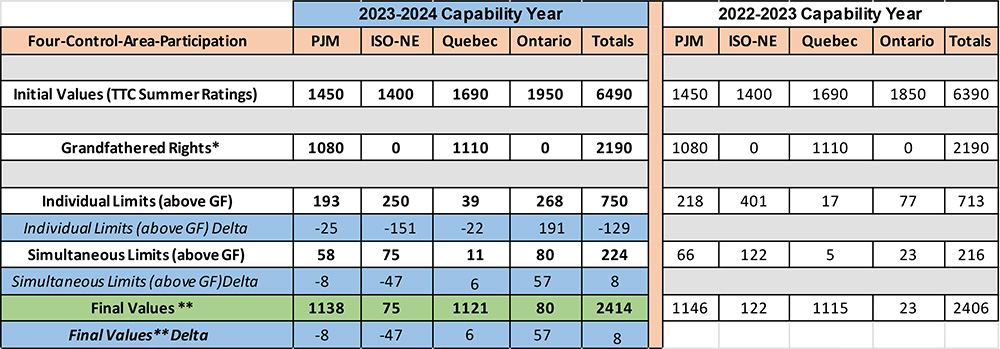FERC last week approved MISO’s Transmission Owners’ request to eliminate reactive power compensation for generators, rejecting multiple protests.
The commission’s Jan. 27 order cited Order 2003, which said generators do not have to be compensated for providing a standard range of reactive power because they’re simply meeting a condition of interconnection (ER23-523).
MISO Transmission Owners in December filed to eliminate reactive power and voltage control charges from their own and unaffiliated generation resources. TOs said the revisions will result in a rate decrease for transmission customers. They argued that the number of unaffiliated generators collecting reactive power compensation has grown to a $220 million annual revenue requirement and climbing. (See MISO TOs File to End Reactive Supply Compensation.)
Under Schedule 2 of MISO’s tariff, most generation owners can apply to receive separate compensation for their reactive supply. The TOs asked FERC to eliminate separate charges to pay for reactive service supplied within the standard power factor range of 0.95 leading to 0.95 lagging.
Several clean energy generation owners accused the TOs of using their agreement with MISO in an “abusive” manner. Groups including the Coalition of Midwest Power Producers, American Clean Power Association and Clean Grid Alliance said MISO TOs lacked the authority to make the change, gave stakeholders just 19 days’ notice that it intended to make the change and failed to vet the proposal in the stakeholder process.
EDF Renewables and Vistra Energy argued many independent power producers in the footprint will suffer harsh financial effects. The Solar Energy Industries Association and Wolverine Power Supply Cooperative contended that eliminating reactive supply compensation could lead to generation developers installing reactive power capabilities only to the bare minimum standard power factor range, setting off a possible shortfall that could keep MISO from returning to reliable operations during an emergency.
The protestors also said the removal of Schedule 2 wasn’t fair because generation-based reactive power won’t be eligible for compensation while MISO TOs will continue to be paid for their transmission-installed reactive devices in their rate bases. They noted that MISO’s 2022 Transmission Expansion Plan includes $146 million of new reactive support and voltage control devices on which the MISO TOs will earn cost recovery plus a rate of return.
But FERC said a reliance on reactive supply compensation isn’t a good enough argument to continue its practice. It said new interconnecting generators must provide standard reactive service as a condition of interconnection and aren’t entitled to payment for doing what’s mandatory.
The commission waved away concerns that MISO’s system reliability could suffer without the compensation. It said other wording in MISO’s tariff allows MISO to compensate a resource if it has to direct it to provide reactive power outside of the standard power factor range.
FERC also said it found no discrimination against independent power producers in the proposal. It said the IPPs are free to try to recover lost reactive power revenue through increased power sales rates, just as TOs’ generating units can through retail rates.
Finally, the commission rejected arguments that TOs can unfairly continue to collect reactive power payments through transmission-installed reactive devices. The commission said the issue at hand related to generation-based reactive power payments, not transmission. It said TOs proposed to treat affiliated and unaffiliated generation alike.
Commissioner James Danly disagreed with the commission’s decision, writing that MISO TOs did not meet their burden of proof that the current rate was unreasonable, given the “substantial unrebutted evidence of the negative rate impacts that this will have on generators not affiliated with the MISO TOs.”
Danly said it was unsatisfactory for MISO TOs to simply cite Order 2003 and previous orders where the commission decided that generators don’t have to be paid for reactive power within the standard range.
Danly argued that in prior cases, FERC “eliminated reactive power compensation when only a handful of unaffiliated generators were receiving — or still seeking — it.”
“The situation in MISO clearly is distinguishable where scores of generators are recovering reactive power compensation and it has been a part of the MISO tariff for years,” Danly wrote.
Commissioner Allison Clements concurred in a separate statement, writing that she would have preferred the MISO TOs use a “different procedural approach” that incorporated more stakeholder input.
She said MISO TOs’ filing is evidence that FERC’s current cost-based methodology for reactive power compensation “is poorly suited for newer technologies and non-synchronous generation like wind, solar, and storage.” She said FERC should act on its Notice of Inquiry opened in 2021 to examine the current regulations associated with reactive power compensation (RM22-2). The commission has not acted in response to comments filed in the docket early last year. (See FERC Seeks Comments on Reactive Power Compensation.)
“Whether or not generators located in MISO were justified in relying on continued reactive power compensation, parties have stated in the record that this decision will cause financial disruption,” she said.
Clements encouraged MISO stakeholders to “consider more effective alternatives to cost-based reactive power compensation.”
“Services should be appropriately compensated for the benefits they provide, and reactive power plays an important reliability function… [S]takeholders may wish to consider market solutions and/or compensation models that are based on the performance of the generators in providing reactive power when called upon, or that incentivize reactive power generation to be located where additional reactive supply is most needed from a reliability perspective,” Clements wrote.

